GRAY MOLD IN GRAPES: The Deadly Silent Rot That Steals Your Yield
What is Gray Mold?
Gray mold, commonly known as Botrytis bunch rot, is a fungal disease caused by Botrytis cinerea. It is a major post-harvest and pre-harvest concern in grape production worldwide, especially under humid or moist conditions and is notorious for destroying grape clusters, especially during ripening and after rainfall near harvest. It can lead to severe crop losses due to fruit decay, reduced marketability, and poor wine quality.
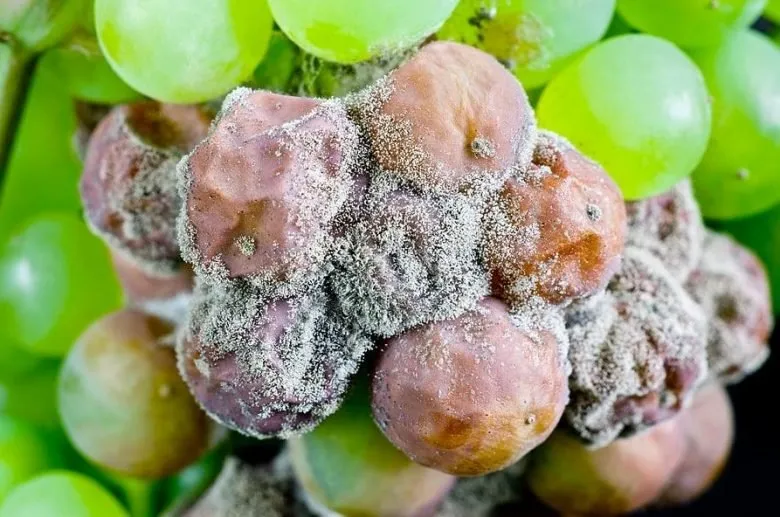
Image credit: Sbenny.com
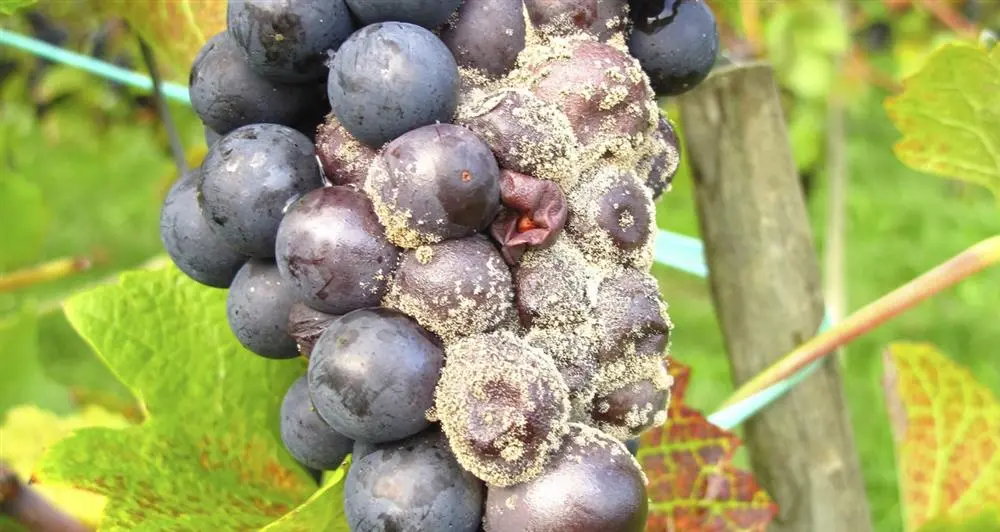
Image credit: PestProphet.com
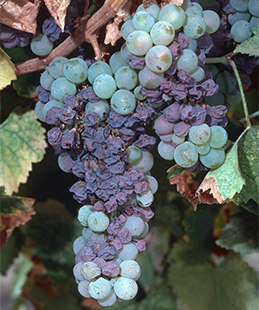
Image credit: PestProphet.com
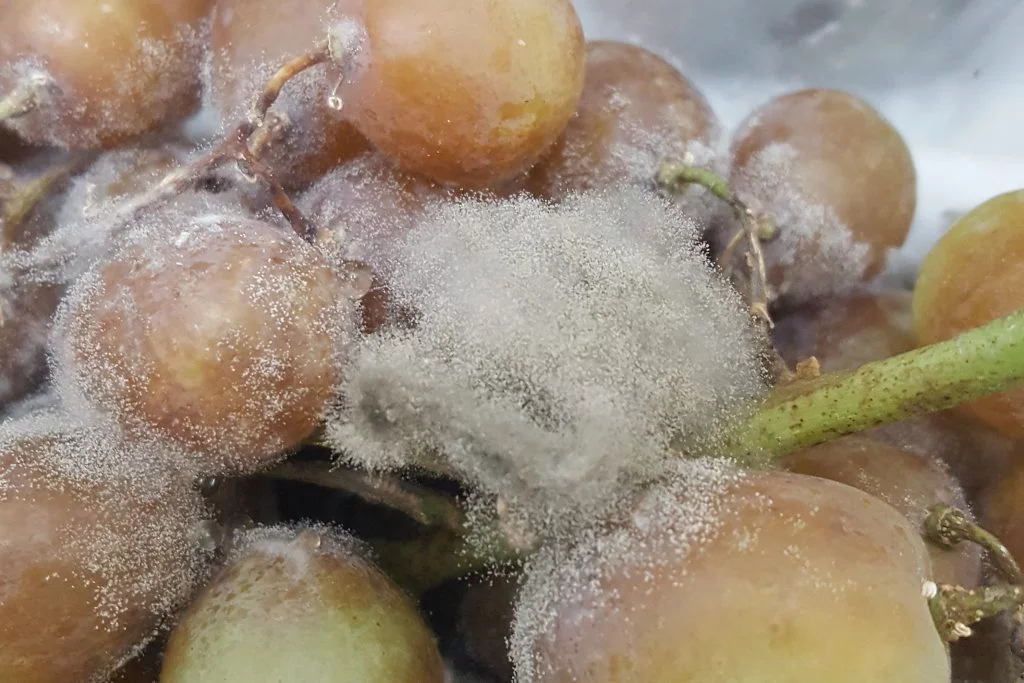
Image credit: PestProphet.com
Table of Contents
Scientific Classification of Pathogen:
- Domain: Eukaryota
- Kingdom: Fungi
- Phylum: Ascomycota
- Class: Leotiomycetes
- Order: Helotiales
- Family: Sclerotiniaceae
- Genus: Botrytis
- Species B. cinerea (The sexual stage, rarely observed, is Botryotinia fuckeliana).
It is a necrotrophic fungus — it kills host tissue and then colonizes the dead matter. It has a broad host range (over 200 species) but is especially aggressive on grape berries.
Symptoms Caused by Gray Mold Pathogen
Botrytis cinerea is a “weak” pathogen, meaning it often exploits senescent (aging), wounded, or dead plant tissues to establish itself, though it can also infect healthy tissue under ideal conditions.
Symptoms On Plants (General):
The most characteristic symptom is a soft, watery rot followed by a fuzzy, grayish-brown mold growth on the infected areas. The fungus typically targets fragile, wounded, aging, or dead plant parts.
Symptoms On Leaves:
Initial infections on leaves may appear as irregular, reddish-brown patches, often V-shaped and localized near the leaf edge or along major veins. Under humid conditions, these lesions can quickly expand and may be covered with the characteristic gray, fuzzy mold. Affected leaves may turn brown, wilt, and eventually drop off. However, leaf symptoms are generally less damaging than those on flowers or fruit.
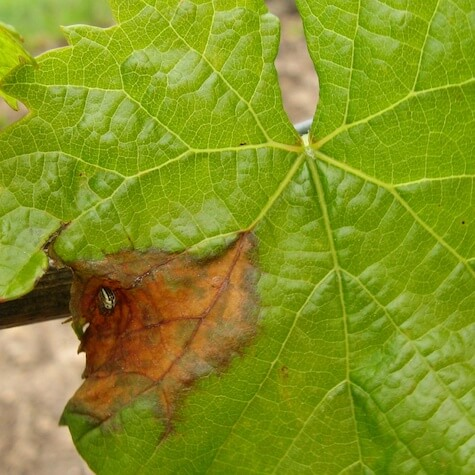
Symptoms on leaves showing Reddish-Brown patch on leaf edge
Image credit: VineForecast.com
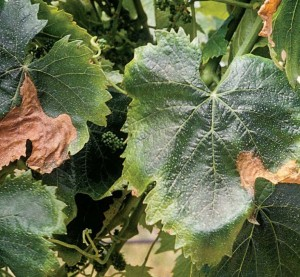
Spring Botrytis infection on leaf. (Photo: L. J. Bettiga)
Image credit: Lodi Winegrape Commission
Symptoms On Twigs, Young Shoots, and Vines (Canes):
Buds and young shoots can be infected in early spring, turning brown and drying out. The fungus can cause blight or rot on buds and stems. Infections often occur in leaf axils, leading to wilting or breaking off of shoots. Affected plant parts, especially those near the soil or within dense canopy, may develop a brownish-gray fungal growth. While possible, direct invasion of actively growing, healthy woody stems is rare; the fungus usually prefers softer, more succulent or wounded tissues.
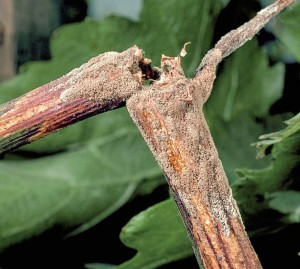
Symptoms on shoot – Rotting of young tissue, covered with fungal spores
Image credit: Lodi Winegrape Commission
Symptoms On Inflorescence (Flowers):
Flower clusters are highly susceptible to infection, particularly during bloom. Infected flower parts (caps, stamens, aborted berries) can provide nutrients for the fungus. The pathogen can invade the inflorescence, leading to blight and premature drying and drop of entire clusters. Infections during bloom often remain quiescent (latent) until fruit begins to ripen, but can then become a source of bunch rot.
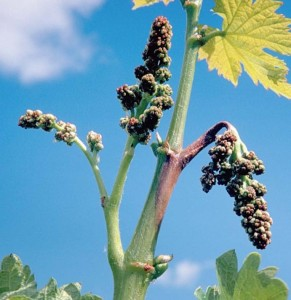
Symptoms on Inflorescence –Botrytis-blighted flower cluster. (Photo: W. J. Moller)
Image credit: Lodi Winegrape Commission
Symptoms On Berries:
This is where gray mold causes the most significant damage. Infections often start on injured berries (e.g., from insect feeding, bird damage, hail, powdery mildew, or growth cracks) or where old flower parts remain attached to the cluster, providing a nutrient source. Initially, berries develop a soft, watery rot. As the disease progresses, the infected berries become covered with a dense, grayish-brown, fuzzy mold, which consists of millions of spores (conidia). Infected berries turn brown (white grapes) or reddish (black grapes). Severely infected berries shrink and dry, forming mummified fruits.The rot can spread rapidly from berry to berry within a compact cluster through direct contact. Infected berries may eventually shrivel and dry out in dry conditions, or remain plump and juicy in wet conditions, eventually collapsing.
The impact of gray mold on bunch quality and quantity is severe. Direct yield losses occur due to infected, unharvestable berries and flower abortion. The tight clusters typical of table and wine grapes facilitate disease spread within the bunch, reducing the number of marketable fruits. Even when the infection seems minor externally, internal rot can cause juice fermentation, resulting in off-flavors and compromised wine quality. Furthermore, the infection leads to a significant reduction in BRIX content (sugar concentration) of the grapes, as photosynthesis is impaired and infected tissues redirect plant sugars toward defense mechanisms instead of fruit ripening. The pathogen also produces enzymes that degrade cell walls and leach sugars, further diluting sweetness.

Botrytis cinerea Spores on Grapes. (Photo by Ed Hellman, OSU)
Image credit: PestProphet.com
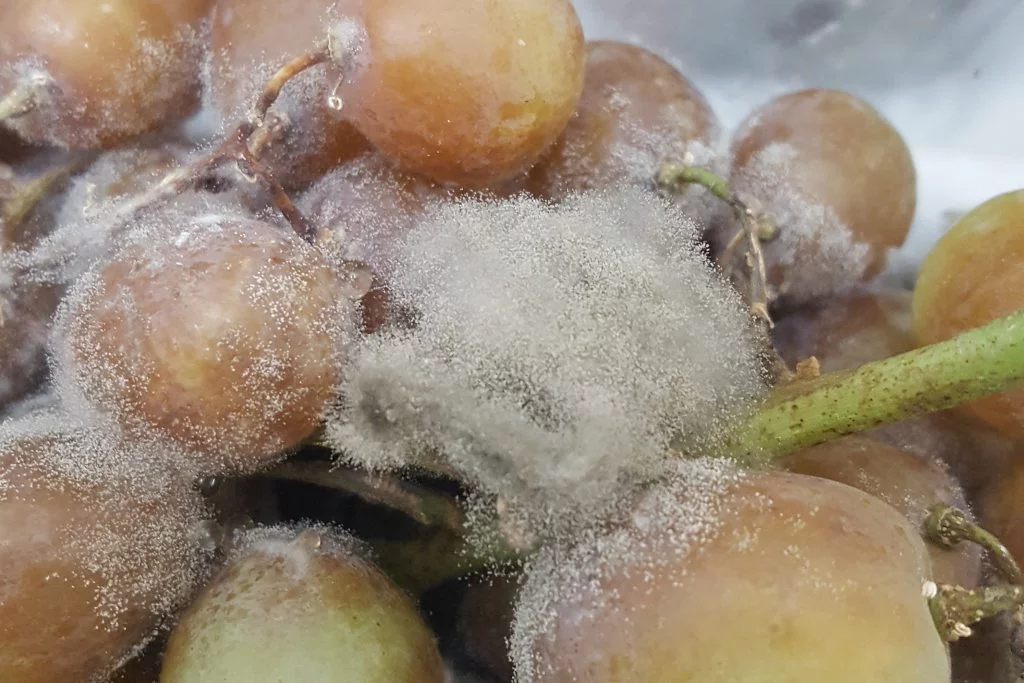
Botrytis cinerea Spores on Grapes Bunch
Image credit: BioProtectionPortal.com
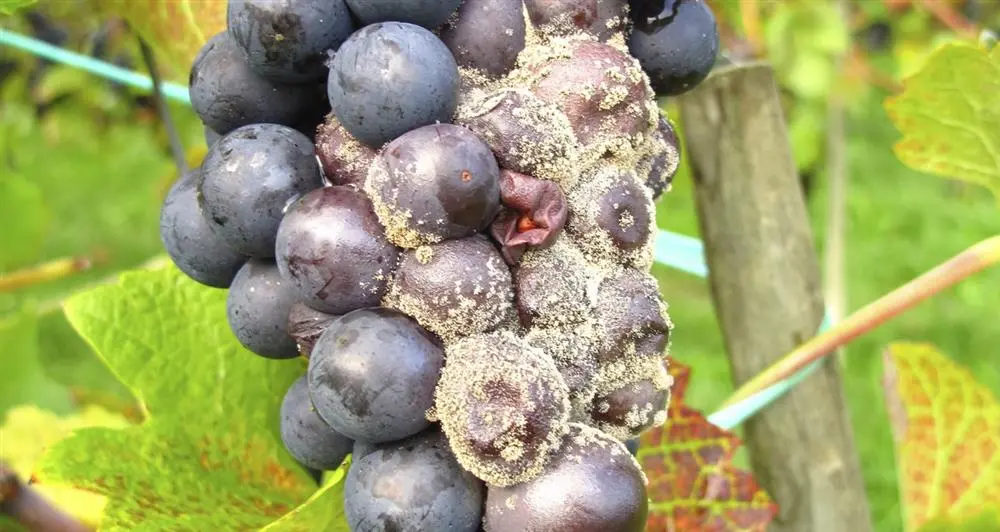
Botrytis cinerea Spores on Grapes Bunch
Image credit: BioProtectionPortal.com
Disease Cycle of Gray Mold in Grapes
Botrytis cinerea, the causal organism of gray mold in grapes, is a necrotrophic fungus that completes its lifecycle by infecting host tissues, producing spores, and spreading via air, water, or physical contact. It has both saprophytic (survives on dead plant matter) and parasitic (infects living tissue) modes of survival, making it one of the most persistent and difficult pathogens to manage.
Primary Source of Infection
The disease cycle begins when Botrytis cinerea overwinters in the vineyard in the form of :
- Sclerotia (hardened fungal bodies)
- Mycelium (fungal threads) inside dead canes, fallen leaves, mummified berries, and plant debris
Dormant conidia (asexual spores) on vine surfaces or pruning wounds
In early spring, as temperature and moisture levels rise, these structures become reactivated. The fungus produces a fresh flush of conidia, which are dispersed by wind, rain splash, irrigation water, or human activity to nearby healthy tissues.This marks the primary infection phase, where conidia germinate and invade young leaves, Emerging shoots, Flower parts, Wounds on canes or developing berries
Botrytis is opportunistic—it prefers to enter through natural openings (like stomata) or wounds (caused by pruning, insect bites, hail, or cracking due to high humidity or over-irrigation).
Secondary Source of Infection
After the initial infection, the pathogen spreads rapidly in the vineyard during periods of high humidity (>90%) and moderate temperatures (18–24°C). The infected tissues produce more conidia, which become the secondary inoculum.
This secondary inoculum is responsible for:
- Inflorescence blight during flowering
- Berry infection at fruit set and pre-harvest stages
- Bunch rot during fruit ripening and post-harvest
Secondary infections are often latent—the pathogen infects flowers or immature berries early, but symptoms remain hidden until the berry matures or becomes stressed (due to tight bunching, poor airflow, or sudden climate changes). This is why latent infections often appear suddenly before or after harvest, making control challenging.
Summary of Disease Cycle Steps
- Overwintering as sclerotia or dormant mycelium in dead plant matter.
- Germination in spring under moist conditions, producing conidia (primary inoculum).
- Initial infection of young tissues and flowers.
- Conidia production from new lesions (secondary inoculum).
- Rapid spread to bunches and berries during wet, humid periods.
- Latent infections activate closer to harvest, leading to sudden bunch rot.
- New sclerotia formation on infected tissues, completing the cycle.
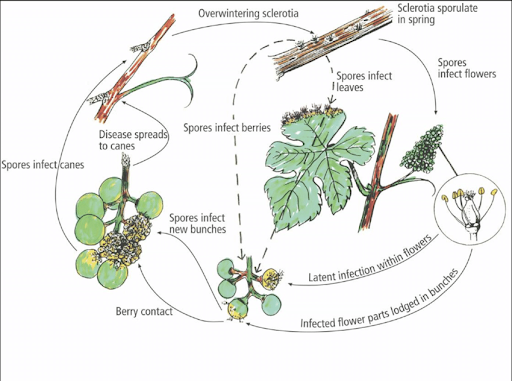
Image credit: MDPI Agriculture Journal
Favorable Conditions
- Temperature: 15°C–25°C
- Relative Humidity: >90%
- Rainfall or dew formation near ripening
- Dense canopy or poor air circulation
Seasonal Pattern of Gray Mold in India
- Pre-Monsoon (March–May): Generally low activity unless under overhead irrigation.
- Monsoon (June–September): Disease remains active with high humidity, particularly during flowering and early berry set.
- Post-Monsoon (October–November): Peak period of disease development during ripening.
- Winter (December–February): Disease pressure declines in dry conditions but may persist in areas with foggy mornings or poor drainage.
Integrated Disease Management
Cultural Practices
- Prune excess shoots to reduce canopy humidity
- Train vines to improve air flow
- Remove infected clusters and mummified berries
- Harvest promptly and avoid overripe berries
- Use rain shelters in vulnerable areas
- Over-Irrigation: Increases humidity around clusters.
- Overuse of Nitrogen: Promotes excessive vegetative growth.
Huntin Organics Sure Shoot Solution for Gray Mold of Grapes
Safe during any crop stage – from pruning to harvest
Organic, residue-free – ideal for fresh & export grapes
Step 1: Kill the Fungal Load
When to Use: Right from the day of pruning and continue till harvesting
Purpose:
- Destroys early-stage spores
- Suppresses latent fungal development
- Prevents Botrytis entry on wounds, inflorescence, or soft tissues
Spray Recipe:
100% – 1 ml/L of water
+ Nano Reach – 1 ml/L of water
Spray Tips:
- Cover all floral parts, leaf surfaces, and developing bunches
- Spray in early morning or late afternoon to avoid rapid drying
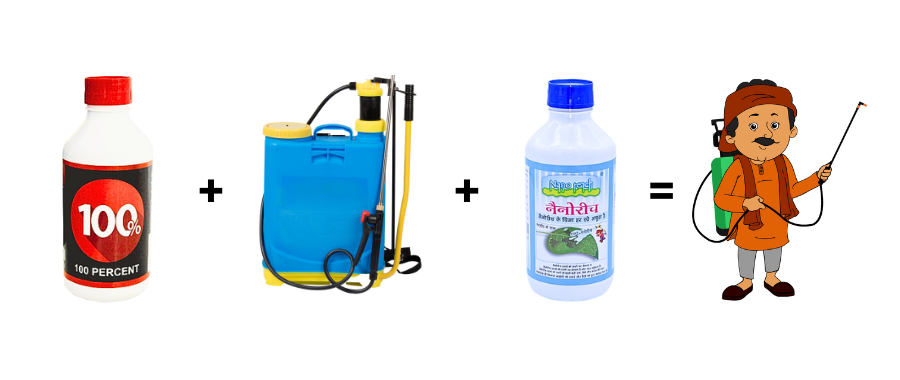
Step 2: Deep Surface Control (after 30 min & within 24 hours of step 1)
- Purpose:
- Kills remaining spores
- Controls fungal hyphae and surface colonization
- Reinforces immunity and strengthens tissue response
Spray Recipe:
Disnil Soil – 1 ml/L water
+ Nano Sulf – 2 ml/L water
+ Nano Reach – 1 ml/L water
Spray Tips:
- Ensure uniform coverage on canopy and bunches
- Apply during cool hours for better absorption and coverage

Spray Frequency Guidelines
| Stage | Spray Interval | Conditions |
| Flowering | Every 10 days | Regular humidity |
| Ripening | Every 10 days | Prevent latent reactivation |
| Rainy/Humid Days | Every 7 days | High Botrytis pressure |
Why Frequent Sprays?
Botrytis cinerea can reproduce every 7–10 days in favorable conditions. If not broken at every stage—spore, hyphae, and sclerotia—it recycles and expands rapidly. Repeat spraying breaks this cycle and protects new growth.
Soil Application of – Seed Grow ++ @ 1 Litre per Acre.
Repeat this application at intervals of every 15 days. Seed Grow++ promotes a healthy root system and efficient mobilization and uptake of nutrients, which strengthens the plant’s natural immune system to fight against disease.
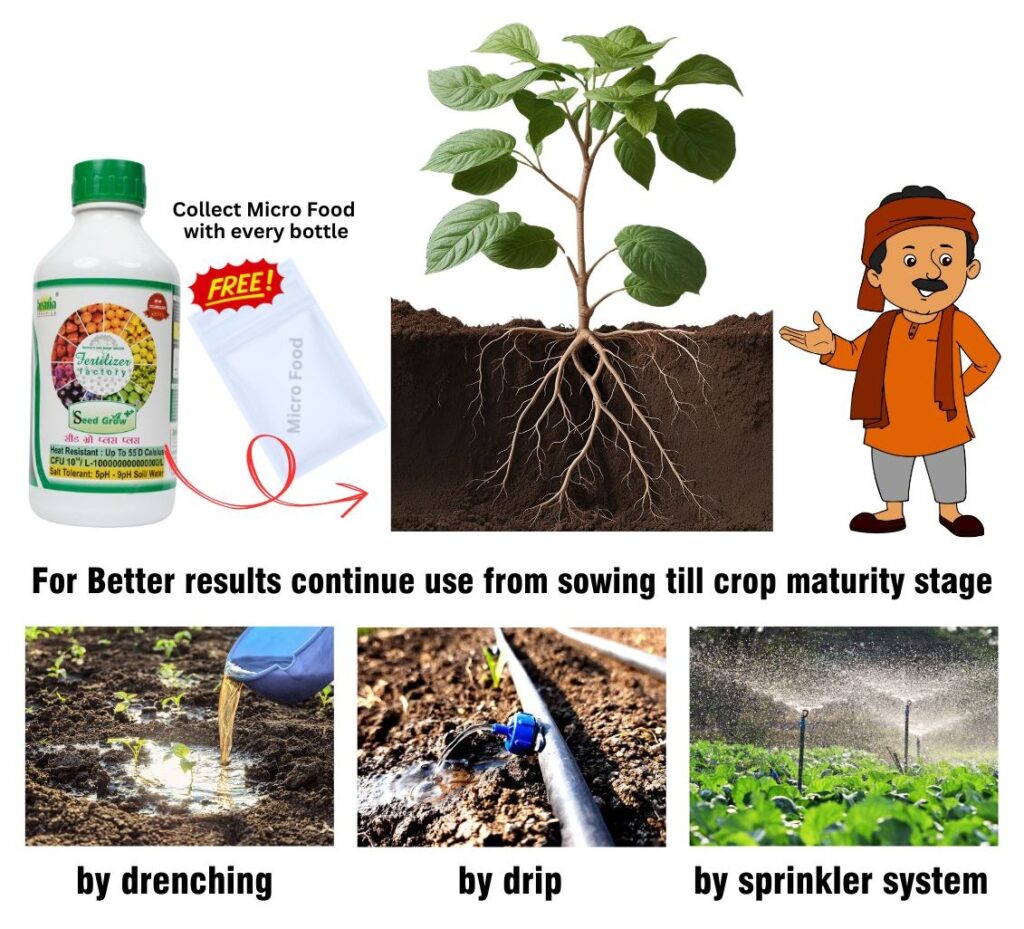
Why This Protocol Works
✔️ Kills latent fungal spores before symptoms appear
✔️ Boosts plant immune responses and photosynthesis
✔️ Improves plant protein synthesis for natural disease resistance
✔️ No chemical residues, safe for market/export
✔️ Eco-safe – protects vineyard biodiversity
✔️ Long-lasting results even under high humidity pressure
A Brief Product Details :
100% – An organic plant extracts having anti-fungal & anti bacterial properties 100 % Percent – Huntinorganics
Nano Reach – A 100% pure silicone-based non-ionic surfactant, spreader, adjuvant that increases stomatal infiltration and spreading of the active ingredient Nano Reach – Huntinorganics
Nano Sulf – A sulfur- and potash-based nano formulation that acts as nutrient, contact fungicide, photosynthesis enhancer.
Disnil soil – Bio fungicide consortium containing Trichoderma v., Trichoderma h., Pseudomonas f., Bacillus s.
Seed Grow ++ is a synergistic combination of highly effective 12 biological strains of Bacteria and Endo mycorrhizae that solubilize and mobilize the plant macro and micronutrients such as N, P, K, Ca, Mg, S, Si, Zn, etc that improves nutrient balance in plant, effective root development, stress management, improvement of soil structure.
Balanced nutrition is the most important factor in plants to fight against any disease.
For more detail on grapes’ diseases & insect pest and its control, please visit – Grape Diseases and Pest Control Guide


